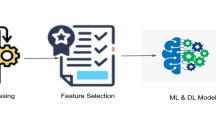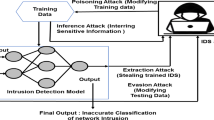Abstract
Cloud computing affords lot of resources and computing facilities through Internet. Cloud systems attract many users with its desirable features. In spite of them, Cloud systems may experience severe security issues. Thus, it is essential to create an Intrusion Detection System (IDS) to detect both insider and outsider attacks with high detection accuracy in cloud environment. This work proposes an anomaly detection system at the hypervisor layer named Hypervisor Detector that uses a hybrid algorithm which is a mixture of Fuzzy C-Means clustering algorithm and Artificial Neural Network (FCM-ANN) to improve the accuracy of the detection system. The proposed system is implemented and compared with Naïve Bayes classifier and Classic ANN algorithm. The DARPA’s KDD cup dataset 1999 is used for experiments. Based on extensive theoretical and performance analysis, it is evident that the proposed system is able to detect the anomalies with high detection accuracy and low false alarm rate even for low frequent attacks thereby outperforming Naïve Bayes classifier and Classic ANN.







Similar content being viewed by others
References
Hai J, Guofu X, Deqing Z (2013) A VMM-based intrusion prevention system in cloud computing environment. J Supercomput Springer Sci + Bus Media 66(3):1133–1151
Oktay U, Sahingoz, OK (2013) Attack types and intrusion detection systems in cloud computing. In: Proceedings of 6th International Information Security & Cryptology Conference, p 71–76, 2013, Ankara, Turkey
Vieira K, Schulter A, Westphall C, Westphall C (2010) Intrusion detection techniques in grid and cloud computing environment. IEEE IT Prof Mag 2010:38–43
SanjayRam M, Velmurugan N, Thirukumaran S (2012) Effective analysis of cloud based intrusion detection system. Int J Comput Appl Inform Technol 1(2):16–22
Amjad HB, Sabyasachi P, Debasish J (2013) Machine learning approach for intrusion detection on cloud virtual machines. Int J Appl Innov Eng Manag 2(6):57–66
Dunlap GW, King ST, Cinar S, Basrai M, Chen PM (2002) Revirt: enabling intrusion analysis through virtual machine logging and replay. In: Proceedings of 5th symposium on operating systems design and implementation. USENIX, Boston, pp 211–224
Chirag NM, Dhiren RP, Avi P, Muttukrishnan R (2012) Integrating Signature Apriori based Network Intrusion Detection System (NIDS) in Cloud Computing. In: Proceedings of 2nd International Conference on Communication, Computing & Security, Procedia Technology, 6:905–912. doi:10.1016/j.protcy.2012.10.110
Feng Z, Hai J (2012) Automated approach to intrusion detection in VM-based dynamic execution Environment. Comput Inform 31:271–297
Garfinkel T, Rosenblum M (2003) A virtual machine introspection based architecture for intrusion detection. In: Proceedings of Network and Distributed Systems Security Symposium (NDSS), p 191–206, 2003
Kourai K, Chiba S (2005) HyperSpector: virtual distributed monitoring environments for secure intrusion detection. In: Proceedings of 1st ACM/USENIX international conference on virtual execution environments. ACM, Chicago, pp 197–207
Bakshi A, Yogesh B (2010) Securing cloud from DDOS attacks using intrusion detection system in virtual machine. In: Proceedings of second International Conference on Communication Software and Networks, p 260–264. doi:10.1109/ICCSN.2010.56
Mazzariello C, Bifulco R, Canonoco R (2010) Integrating a network IDS into an Open source Cloud computing environment. In: Information Assurance and Security (IAS), 2010 Sixth International Conference on, pp. 265–270. IEEE, 2010, Atlanta, GA, USA
Jones AK, Sielken RS (2000) Computer system intrusion detection: A survey. (Online) http:// www.cs.virginia.edu/_jones/IDS-research/Documents/jones-sielken-survey-v11.pdf
Keiko H, David GR, Eduardo FM, Eduardo BF (2013) An analysis of security issues for cloud computing. J Internet Serv Appl 4(5):1–13
Modi C, Patel D, Borisaniya B, Patel H, Patel A, Rajarajan M (2013) A survey of intrusion detection techniques in Cloud. J Netw Comput Appl 36(1):42–57
Gens F (2008) IT Cloud Services User Survey, pt.2: Top Benefits & Challenges. (Online) http://blogs.idc.com/ie/?p=210
Nirmala AP, Sridaran R (2012) Cloud computing issues at design and implementation levels-A survey. Int J Adv Netw Appl 3(6):1444–1449
Vikrant GD, Atul GB, Nikhil AA (2013) Intrusion detection system for cloud computing. Int J Eng Res Technol (IJERT) 2(4):2149–2153
Farzad S (2012) Secure virtualization for cloud environment using hypervisor-based technology. Int J Mach Learn Comput 2(1):39–45
Vinothina V, Sridaran R, Padmavathi G (2012) A survey on resource allocation strategies in cloud computing. Int J Adv Comput Sci Appl 3(6):97–104
Witcha C, Abdul HA, Mohd NMS, Siriporn C, Surat S (2007) A rough fuzzy hybrid algorithm for computer intrusion detection. Int Arab J Inform Technol 4(3):247–254
Gang W, Jinxing H, Jian M, Lihua H (2010) A new approach to intrusion detection using Artificial Neural Networks and fuzzy clustering. Expert Syst Appl 37(9):6225–6232
Anderson J (1995) An introduction to neural networks. MIT Press, Cambridge
Haykin S (1999) Neural networks: a comprehensive foundation, 2nd ed. Prentice-Hall Inc, Englewood Cliffs, NJ
Mahbod T, Ebrahim B, Wei L, Ali A, Ghorbani A (2009) Detailed analysis of the KDD CUP 99 data set. In: Proceedings of the Second IEEE Symposium on Computational Intelligence for Security and Defence Applications 2009, pp.1–7, Ottawa, Canada
Shanmugavadivu R, Nagarajan N (2011) Network intrusion detection system using fuzzy logic. Ind J Comput Sci Eng 2(1):101–111
Author information
Authors and Affiliations
Corresponding author
Rights and permissions
About this article
Cite this article
Pandeeswari, N., Kumar, G. Anomaly Detection System in Cloud Environment Using Fuzzy Clustering Based ANN. Mobile Netw Appl 21, 494–505 (2016). https://doi.org/10.1007/s11036-015-0644-x
Published:
Issue Date:
DOI: https://doi.org/10.1007/s11036-015-0644-x




